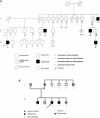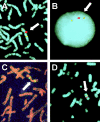Additional copies of the proteolipid protein gene causing Pelizaeus-Merzbacher disease arise by separate integration into the X chromosome
- PMID: 10827108
- PMCID: PMC1287072
- DOI: 10.1086/302965
Additional copies of the proteolipid protein gene causing Pelizaeus-Merzbacher disease arise by separate integration into the X chromosome
Abstract
The proteolipid protein gene (PLP) is normally present at chromosome Xq22. Mutations and duplications of this gene are associated with Pelizaeus-Merzbacher disease (PMD). Here we describe two new families in which males affected with PMD were found to have a copy of PLP on the short arm of the X chromosome, in addition to a normal copy on Xq22. In the first family, the extra copy was first detected by the presence of heterozygosity of the AhaII dimorphism within the PLP gene. The results of FISH analysis showed an additional copy of PLP in Xp22.1, although no chromosomal rearrangements could be detected by standard karyotype analysis. Another three affected males from the family had similar findings. In a second unrelated family with signs of PMD, cytogenetic analysis showed a pericentric inversion of the X chromosome. In the inv(X) carried by several affected family members, FISH showed PLP signals at Xp11.4 and Xq22. A third family has previously been reported, in which affected members had an extra copy of the PLP gene detected at Xq26 in a chromosome with an otherwise normal banding pattern. The identification of three separate families in which PLP is duplicated at a noncontiguous site suggests that such duplications could be a relatively common but previously undetected cause of genetic disorders.
Figures



Comment in
-
Breaking away from home.Am J Hum Genet. 2000 Jul;67(1):1-3. doi: 10.1086/302982. Epub 2000 May 25. Am J Hum Genet. 2000. PMID: 10827110 Free PMC article. No abstract available.
Similar articles
-
Breaking away from home.Am J Hum Genet. 2000 Jul;67(1):1-3. doi: 10.1086/302982. Epub 2000 May 25. Am J Hum Genet. 2000. PMID: 10827110 Free PMC article. No abstract available.
-
Complex chromosomal rearrangement and associated counseling issues in a family with Pelizaeus-Merzbacher disease.Am J Med Genet A. 2003 Apr 1;118A(1):15-24. doi: 10.1002/ajmg.a.10103. Am J Med Genet A. 2003. PMID: 12605435
-
Insertion of an extra copy of Xq22.2 into 1p36 results in functional duplication of the PLP1 gene in a girl with classical Pelizaeus-Merzbacher disease.BMC Med Genet. 2015 Sep 2;16:77. doi: 10.1186/s12881-015-0226-6. BMC Med Genet. 2015. PMID: 26329556 Free PMC article.
-
Pelizaeus-Merzbacher disease.J Neuropathol Exp Neurol. 2002 Sep;61(9):747-59. doi: 10.1093/jnen/61.9.747. J Neuropathol Exp Neurol. 2002. PMID: 12230321 Review.
-
Pelizaeus-Merzbacher disease as a chromosomal disorder.Congenit Anom (Kyoto). 2013 Mar;53(1):3-8. doi: 10.1111/cga.12005. Congenit Anom (Kyoto). 2013. PMID: 23480352 Review.
Cited by
-
Neural stem cells restore myelin in a demyelinating model of Pelizaeus-Merzbacher disease.Brain. 2020 May 1;143(5):1383-1399. doi: 10.1093/brain/awaa080. Brain. 2020. PMID: 32419025 Free PMC article.
-
Genomic rearrangements resulting in PLP1 deletion occur by nonhomologous end joining and cause different dysmyelinating phenotypes in males and females.Am J Hum Genet. 2002 Oct;71(4):838-53. doi: 10.1086/342728. Epub 2002 Sep 20. Am J Hum Genet. 2002. PMID: 12297985 Free PMC article.
-
Breaking away from home.Am J Hum Genet. 2000 Jul;67(1):1-3. doi: 10.1086/302982. Epub 2000 May 25. Am J Hum Genet. 2000. PMID: 10827110 Free PMC article. No abstract available.
-
Proteolipid protein cannot replace P0 protein as the major structural protein of peripheral nervous system myelin.Glia. 2015 Jan;63(1):66-77. doi: 10.1002/glia.22733. Epub 2014 Jul 28. Glia. 2015. PMID: 25066805 Free PMC article.
-
Control of human PLP1 expression through transcriptional regulatory elements and alternatively spliced exons in intron 1.ASN Neuro. 2015 Feb 18;7(1):1759091415569910. doi: 10.1177/1759091415569910. Print 2015 Jan-Feb. ASN Neuro. 2015. PMID: 25694552 Free PMC article.
References
Electronic-Database Information
-
- GenBank Genetic Sequence Database, http://helix.nih.gov/science/genbank.html
-
- Human Genome Sequencing Center, Baylor College of Medicine, http://www.hgsc.bcm.tmc.edu/index.html (for three YACs [122e11, 226c9, and 526g7] containing the PLP gene)
-
- Online Mendelian Inheritance in Man (OMIM), http://www.ncbi.nlm.nih.gov/Omim/ (for PMD [MIM 312080] and X-linked SPG2 [MIM 312920])
-
- Sanger Centre, The, http://www.sanger.ac.uk/HGP/ChrX/
References
-
- Chance PF, Bird TD, Matsunami N, Lensch MW, Brothman AR, Feldman GM (1992) Trisomy 17p associated with Charcot-Marie-Tooth neuropathy type 1A phenotype: evidence for gene dosage as a mechanism in CMT1A. Neurology 42:2295-2299 - PubMed
-
- Cremers FPM, Pfeiffer RA, van de Pol TJR, Hofker MH, Kruse TA, Wieringa B, Ropers HH (1987) An interstitial duplication of the X chromosome in a male allows physical fine mapping of probes from the Xq13-q22 region. Hum Genet 77:23–27 - PubMed
-
- Ellis D, Malcolm S (1994) Proteolipid protein gene dosage effect in Pelizaeus-Merzbacher disease. Nat Genet 6:333–334 - PubMed
-
- Harding AE (1995) From the syndrome of Charcot, Marie and Tooth to disorders of peripheral myelin proteins. Brain 118:809–818 - PubMed
-
- Harding B, Ellis D, Malcolm S (1995) A case of Pelizaeus-Merzbacher disease showing increased dosage of the proteolipid protein gene. Neuropathol Appl Neurobiol 21:111–115 - PubMed
Publication types
MeSH terms
Substances
Grants and funding
LinkOut - more resources
Full Text Sources
Other Literature Sources
Research Materials

